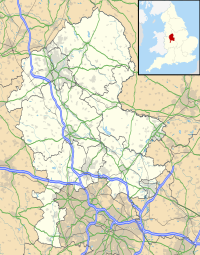
Stoke-upon-Trent, also known as Stoke, is one of the six towns that along with Hanley, Burslem, Fenton, Longton and Tunstall form the city of Stoke-on-Trent, in Staffordshire, England.

Burslem is one of the six towns that along with Hanley, Tunstall, Fenton, Longton and Stoke-upon-Trent form part of the city of Stoke-on-Trent in Staffordshire, England. It is often referred to as the "mother town" of Stoke on Trent. The population of the town was included under the Burslem Central ward and had a population of 6,490 in the 2021 Census.

Stoke-on-Trent railway station is a mainline railway station serving the city of Stoke-on-Trent, on the Stafford to Manchester branch of the West Coast Main Line. It also provides an interchange between local services running through Cheshire, Staffordshire and Derbyshire.

Smallthorne is an area in the city of Stoke-on-Trent in Staffordshire, England. It is in the north-east of the city, near Burslem. Smallthorne borders Bradeley and Chell in the north, Norton-in-the-Moors in the east, Sneyd Green in the south, and Burslem in the west.
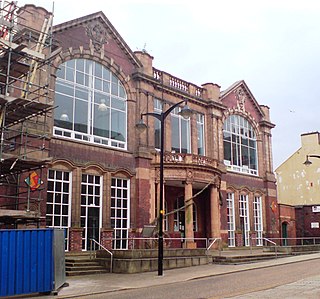
Burslem School of Art was an art school in the centre of the town of Burslem in the Potteries district of England. Students from the school played an important role in the local pottery industry. Pottery was made on the site of the school from the early Middle Ages. The venue was refurbished and re-opened for the arts in 1999.

Longport is an area of Stoke-on-Trent, England. It is the location for Longbridge Hayes industrial estate.

2–18 St Werburgh Street is a terrace consisting of a bank, shops and offices on the east side of St Werburgh Street and the north side of Eastgate Street, Chester, Cheshire, England. The terrace is recorded in the National Heritage List for England as a designated Grade II* listed building.

William Mortimer (1841/42–1913) was an architect working in Lincoln from around 1858. He also played for the Lincolnshire County Cricket team.
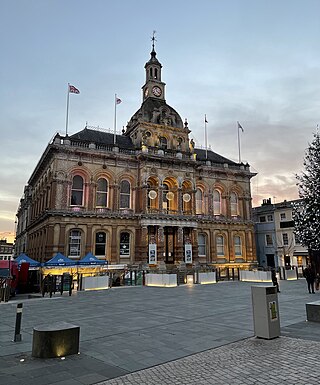
Bellamy and Hardy was an architectural practice in Lincoln, England, that specialised particularly in the design of public buildings and non-conformist chapels. Pearson Bellamy had established his own architectural practice by 1845 and he entered into a partnership with James Spence Hardy in June 1853. Both partners had previously worked for the Lincoln architect William Adams Nicholson. Hardy was described as "Chief Clerk" to Nicholson. Hardy joined Pearson Bellamy immediately after the sudden death of Nicholson. As all known architectural drawings by the practice are signed Pearson Bellamy, it is likely that Bellamy was the architect and Hardy was the administrator in the practice. The partnership lasted until 1887. Bellamy continued to practise until 1896.
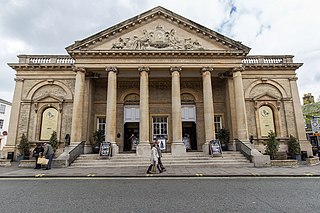
Corn exchanges are distinct buildings which were originally created as a venue for corn merchants to meet and arrange pricing with farmers for the sale of wheat, barley, and other corn crops. The word "corn" in British English denotes all cereal grains, such as wheat and barley. With the repeal of the Corn Laws in 1846, a large number of corn exchanges were built in England, particularly in the corn-growing areas of Eastern England.
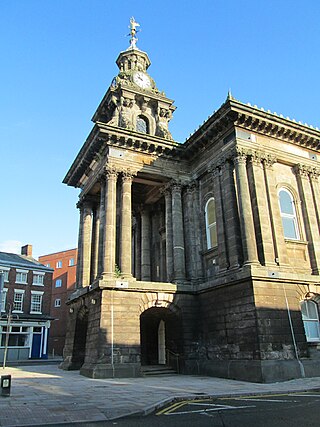
The Old Town Hall is a former town hall in Burslem, in Staffordshire, England. It is in the Market Place, in the centre of the town. It is a Grade II* listed building, listed on 2 October 1951.

St John the Baptist's Church is an Anglican church in Burslem, Stoke-on-Trent, Staffordshire, England. It is a Grade II listed building.
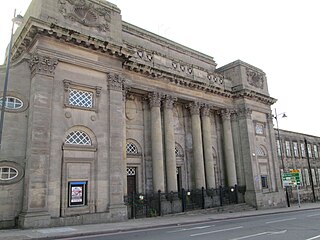
The Queen's Theatre is a theatre building in Burslem, Stoke-on-Trent, England. It is situated in Wedgwood Street in the town centre.

Stoke-upon-Trent Town Hall is a municipal building in Glebe Street, Stoke-upon-Trent, Staffordshire, England. The town hall, which is the meeting place of Stoke-on-Trent City Council, is a Grade II listed building.

Tunstall Town Hall is a municipal building in the High Street in Tunstall, Staffordshire, England. The structure, which was the meeting place of Tunstall Urban District Council, is a Grade II listed building.

The Queen's Hall, formerly Hexham Town Hall, is a municipal structure in Beaumont Street, Hexham, Northumberland, England. The structure, which was the headquarters of Hexham Urban District Council and is now an arts centre, is a Grade II listed building.

Garstang Town Hall is a municipal building in the High Street in Garstang, Lancashire, England. The structure, which currently accommodates two shops and a Royal British Legion Club, is a Grade II listed building.

Fenton Town Hall is a municipal building in Albert Square in Fenton, Staffordshire, England. It is now occupied by local businesses, a café and an art gallery.

Hanley Town Hall is a municipal building in Albion Square in Hanley, Staffordshire, England. The building, which is used as the local register office, is a Grade II listed building.
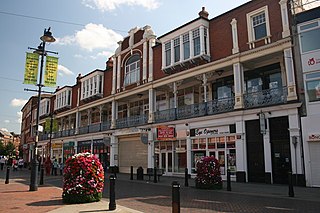
Victorian Arcade, in Walsall, West Midlands, is a shopping arcade in the town centre, built in the 1890s. It is a Grade II listed building;

